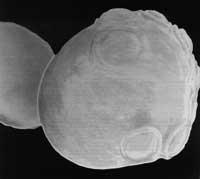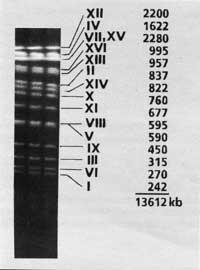Project "Human Genome"
1993/08/01 Elhuyar Zientzia Iturria: Elhuyar aldizkaria
Marga Subarte
Currently, the project is underway to identify and locate more than 50,000 human genes present in the DNA molecule of our chromosomes and define the complete sequence of ACGT nucleotides of the entire human genome. The work can be completed in 2005. Once the map and sequencing have been completed, the role of genes, differences between species, and the relationships of these differences with diseases will be studied.
The project “Human Genome” will therefore have three phases: map elaboration, sequencing and research on the function and variation of the genome. In addition to medicine, biology will offer a lot of information for the future. It is a singular project in biology in terms of its extension and general applications. The special attention paid to the possible ethical, legal and social effects has also been unique.

The map of the genome advances very quickly and any printed version on the anatomy of the human genome is quickly obsolete. About 40% of the genes indicated in the genome are expected to be fixed on the map over the next five years. In total we have approximately 6,000 human genes, with a total of approximately 50,000. About 600 human genetic diseases have already been assigned to their gene.
The first results of the “Human Genome” project are available to us thanks to the many discoveries made in the ills we have been investigating for a long time. This project will have a great impact on clinical medicine. Researchers from all areas of medicine are applying the genetic map to determine the genetic agents of some diseases. These factors are the ease with which the disease develops and the original causes of it.
One of the most important results can be cancer. Cancers are genetic diseases, although most do not go through inheritance. Therefore, preventive work can be carried out easily in families with high rates of breast, ovarian, bowel, and other places.
The “Human Genome” project will intensify our knowledge of functionalism as healthy human beings. It will highlight the chemical bases of our 4,000 genetic diseases. The design of genetic disease detection and diagnosis tests will be immediate and the bases for new treatments will be established.
From the beginning of the project it was clear that the responsible and adequate use of genetic information would generate problems. Experts in developing security measures to search for practical applications to genetic information in other states, such as the US, have developed programs. Through other projects, studies are being conducted so that entrepreneurs and insurance companies can impartially use genetic information and safeguard the privacy of people.
We may never know ourselves completely biologically. However, we must know all our genes in order to begin to understand how diseases that shorten our lives act.
In a recent international meeting held in Bilbao by scientists and jurists, the effects of the genetic map on law have been analyzed, in order to achieve an entity that regulates the application of knowledge acquired following the project “Human Genome”. The need for supranational legislation to regulate future applications of the genetic map was underlined. And in the different nations there are very different laws on genetic research and its social, ethical and educational implications.
The main disagreement between scientists and jurists from the United States and Europe is to patent the findings derived from the “Human Genome” project. Experts want germinal cells to be manipulated internationally.
On the other hand, researchers demonstrate the total freedom of their scientific papers. The only limitation is self-control of the researcher and respect for human rights. Another of the conclusions of the meeting is that each person has his own human genome and his right to preserve his intimacy since the aggression.

Gai honi buruzko eduki gehiago
Elhuyarrek garatutako teknologia





